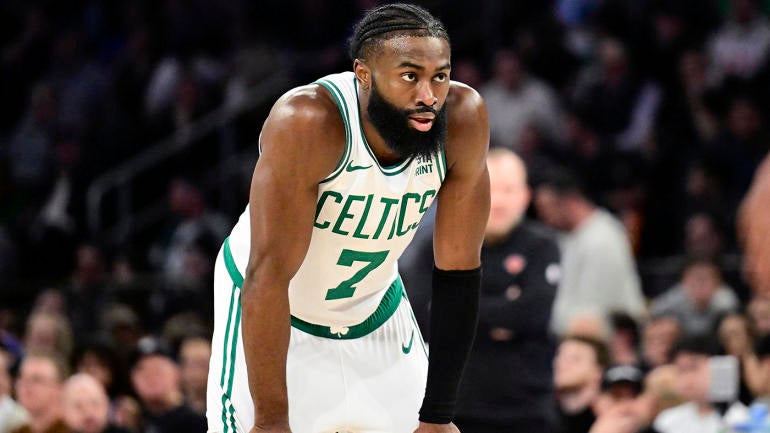
Remember the news cycle when Jaylen Brown signed his record-breaking contract this offseason? At the time, the reporting surrounding his deal was focused on his newfound status as the NBA's first $300 million player. We even took a stab at projecting who the league's first $400 million player would be. That figure was so enormous that most headlines treated it as a fact.
And yet, an eagle-eyed Redditor noticed that Spotrac's projection on Brown's deal changed slightly last week. As of this moment, his new contract is expected to pay him $286.23 million between the 2024-25 and 2028-29 seasons. The contract was not based on incentives. Even if it was, the season hasn't even ended yet. How have the terms of Brown's contract changed?
Well... they haven't. In fact, the terms of the contract haven't even been fully set yet. What's happening here relates to an interesting quirk in how max salaries are determined in the NBA. Brown's status as the NBA's first $300 million player will ultimately be determined by economic factors that are out of his control.
Why? Because the max salary in a specific season is based on the salary cap. Brown's supermax deal calls for him to earn 35% of the salary cap in the first season of his contract. Here's where things get complicated. Brown signed his deal during the 2023 offseason, but the deal itself didn't kick in until the 2024-25 campaign. In other words, he signed for 35% of a salary cap that hadn't yet been determined.
At the time, most projections assumed that the NBA would see its salary cap rise by the maximum allowable 10% next offseason. That would have taken the cap up to $149,623,100. Were Brown to earn 35% of that figure, his salary for the 2024-25 season would have been $52,368,085, and with the maximum allowable 8% annual raise of $4,189,446, the total value of Brown's contract would have come to $303,734,885. Round that up, and you get the widely-floated $304 million figure.
But last week, the NBA released a new projection for the 2024-25 salary cap. That number is a more modest $141 million, still a rise on this season's $136,021,000 cap but not close to the full 10% the cap is legally allowed to rise. This effectively did two things to lower the projected value of Brown's contract:
- It lowered the first-year salary from a projected $52,368,085 to a new estimated projection of $49,350,000, which would be 35% of the newly projected $141 million cap.
- It lowered the annual raise Brown was eligible to receive. Maximum contract raises are fixed at 8% of the first year's salary. Therefore, instead of receiving $4,189,446 raises each season, this new projection calls for Brown to receive annual raises of $3,948,000.
By starting at a lower figure and receiving smaller annual raises, the total value of Brown's projected contract declined by around $17.5 million. Here's what the two projected contracts look like side by side:
Original projection |
Current projection |
|
2024-25 salary |
$52,368,085 |
$49,350,000 |
2025-26 salary |
$56,557,531 |
$53,298,000 |
2026-27 salary |
$60,746,977 |
$57,246,000 |
2027-28 salary |
$64,936,423 |
$61,194,000 |
2028-29 salary |
$69,125,869 |
$65,142,000 |
Total contract value |
$303,734,885 |
$286,230,000 |
So does this mean we can reasonably expect Brown to miss out on the title of "first $300 million player in NBA history?" Well... it's too early to tell. Just because the current projection is coming in low doesn't mean the final number actually will. The NBA has made a habit recently of releasing conservative initial estimates. Both the 2023-24 and 2022-23 caps rose by a maximum of 10% after previous projections suggested that they wouldn't. It's entirely possible that the 2024-25 cap follows the same projection and pushes Brown back over the $300 million line.
Whether or not it ultimately does, though, is unknowable at the moment. The cap is set based on projected revenue, so while current league earnings do factor into those projections, they can always change for any number of reasons between now and the July moratorium. Maybe the NBA finds some new, untapped gold mine that takes the cap up to the 10% limit. Maybe the next few months go poorly, and the final number will be lower than the current projection. History tells us that we're likelier to see higher cap growth, but that isn't exactly set in stone.
Does it ultimately matter whether or not Brown is the NBA's first $300 million player? Not really, no. The Celtics will pay him as much as they are legally allowed to on his next deal. It's just that such contracts don't carry fixed values until they actually kick in. Brown would surely prefer the history-making title, and the $17.5 million or so that it could come with probably means a fair bit to him as well. But the final number on the deal is out of his control. He's going to be a very wealthy man when this new contract begins, but we're still a few months away from knowing exactly how wealthy he's going to be.

